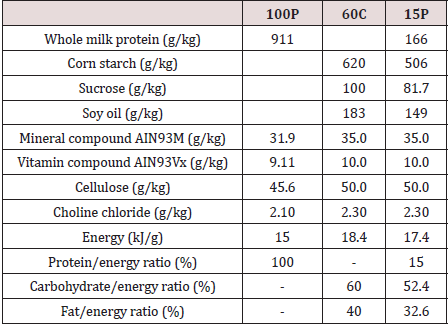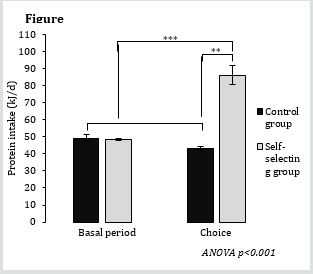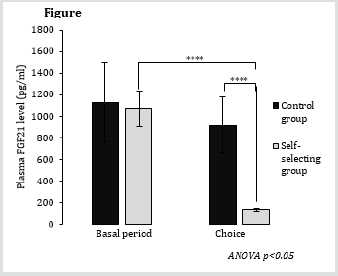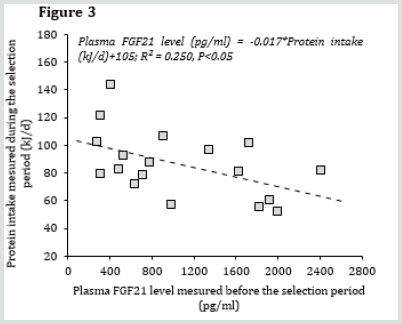Lupine Publishers| Journal of Diabetes and Obesity
Introduction
Fibroblast growth factor 21 (FGF21) is a hepatokine member of
a subfamily of “fibroblast growth factors” that responds to multiple
metabolic stresses as protein deficiency [1-4]. FGF21 is produced
in various tissues but the FGF21 circulating form is primarily
of hepatic origin [1,2]. FGF21 affects numerous metabolic and
behavioural parameters, and in particular, increases appetite for
protein in subjects fed a protein-deprived diets [5,6]. In a recent
still unpublished study, we observed that plasma FGF21 levels were
higher in adult male Wistar rats fed a standard diet, formulated
according the AIN93 recommendations for rats’ feed, containing
15% protein by energy [7] than in rats fed a 30% protein diet. In
addition, inter-individual variability of plasma FGF21 levels was
larger in rats fed the standard 15% protein diet than in rats fed
the 30% protein diet. We therefore considered the hypothesis
that higher levels and inter-individual variability in plasma FGF21
levels in rats fed a standard 15% protein diet would reflect the
variability in protein requirements between individuals and thus,
that measurement of plasma FGF21 levels can be used as a simple,
rapid, and minimally-invasive test to estimate the adequacy of
protein intake.
Dietary self-selection is a method that has been largely used
in farm animals and laboratory rodents to study the requirements
for macronutrients (carbohydrates, lipids and proteins), vitamins
and minerals [8,9]. Many studies using this method, in our lab and
others, showed that rats self-selecting between a protein diet and
a protein-free diet often ingest up to 30-50% of total energy intake
as protein [10-15], so much higher than the level considered as
sufficient for an optimal growth in adult rats (10-15% by energy),
which comforted our hypothesis that 15% dietary protein was
possibly not the optimal dietary content.
The objective of this study was to verify that variability in
plasma FGF21 levels in rats fed a standard 15% protein diet was
indicative of differences in protein requirements. To this end, we
have analyzed the relationship between FGF21 levels, and the level
of protein subsequently selected during self-selection between a
protein diet and a protein-free diet.
Experimental Procedure
24 adult male rats (215-240g) of the Wistar RccHan strain (ENVIGO) were used and individually housed (22°C ± 1°C, 12/12 L/D, cycle lights on at 08:00). After 1 week of adaptation to the laboratory conditions, the rats were fed for 12 days (Basal period) a standard diet formulated according to the AIN93 requirements [7] that contained 15% protein (15P); then, for 28 days (Choice period), 6 rats (Control group) continued to be fed with the standard diet and 18 (Self-selecting group) were given a choice between a pure protein diet (100P) and a protein-free diet containing a mix of fat (soy oil) and carbohydrate (corn starch and sucrose) in which carbohydrate amounted 60% by energy. The diets were provided, as necessary.
The food pellets were prepared twice a week by mixing the macronutrients, vitamins, and mineral mix with the amount of water required to make a thick dough. Food intake (g/day) was measured twice a week and converted in kJ/day based on the energy content of the diets (Table 1).
Table 1: Composition and energy content of the 3 used diets.

100P: diet containing only proteins; 60C: protein-free diet containing only lipids and carbohydrates and in which carbohydrates amounted 60% by energy; 15P: standard diet containing 15% of protein by energy.
Blood samples (0.5 mL) were collected from the tail vein in EDTA tubes: once during the basal period and once during the choice period. Blood collection was made in the morning (10:00- 12:00) in rats that were not previously fasted. Blood samples were centrifuged (5000g, 15min, 4°C) and the plasma stored at -20°C. Plasma FGF21 levels (pg/ml) were measured by ELISA tests using commercial kits from Bio Vendor (Mouse/Rat FGF-21 ELISA RD291108200R).
Statistical Analysis
Statistical tests were performed using RStudio software, 2015. Changes in protein intake and plasma FGF21 level were compared using mixed two-factor ANOVA tests (parameter ~ group*period), which were followed by the main effects analysis by Bonferroni adjusted pairwise comparisons. Values are presented as means ± standard error of the mean (SEM). Linear regression analysis was used to study the link between plasma FGF21 levels during the basal period and protein intake during the choice period and was performed using Excel software. Significance of correlations was assessed using the Pearson correlation coefficient. A threshold of P≤0.05 was chosen as significant.
Results and Discussion
Protein intake was similar between the control and selfselecting group during the basal period but increased by 80% in the self-selecting group during the choice period (+37.8 kJ/d, p<0.0001) (Figure 1). This response significantly increased the contribution of protein to total energy intake from 15.0% to 23.5% (p<0.001). Mean plasma FGF21 levels averaged ~1,100 pg/mL in both groups during the basal period and decreased to 131 pg/mL in self-selecting group during the choice period (P<0.001) (Figure 2). Finally, contrary to our hypothesis, not only did we not observe a positive correlation between plasma FGF21 levels during the basal period and protein intake during the choice period, but instead we observed a weak and inverse correlation (Figure 3).
Figure 1: Protein intake (kJ/d) according to diet group and period.
(*:0.05; **:0.01; ***:0.001; ****:0.0001) Values are represented as
means ±SEM, only the p-value of the interaction of ANOVA tests
are indicated.

Figure 2: FGF21 level in plasma (pg/ml) according to diet group and period.
(*:0.05; **:0.01; ***:0.001; ****:0.0001) Values are represented as
means ±SEM, only the p-value of the interaction of ANOVA tests
are indicated.

Figure 3: Protein intake (kJ/d) during the choice period as a function of plasma FGF21 levels during the basal period in the self-selecting group.

Conclusion
In conclusion, inter-individual variability in plasma FGF21 levels in rats fed a standard 15% protein diet did not appear to be a parameter sensitive enough to reflect inter-individual differences in protein requirements. Therefore, plasma FGF21 level cannot be used as a test to determine inter-individual variability in protein requirements in individuals. Nevertheless we observed that plasma FGF21 levels in P15 fed rats were ~7 fold higher than in selfselecting rats ingesting 23.5% protein, which points on the fact that changes in plasma FGF21 levels are very sensitive to dietary protein intake, even when protein intake is well above essential protein requirements (~8-10 % in adult male rats).

No comments:
Post a Comment
Note: only a member of this blog may post a comment.